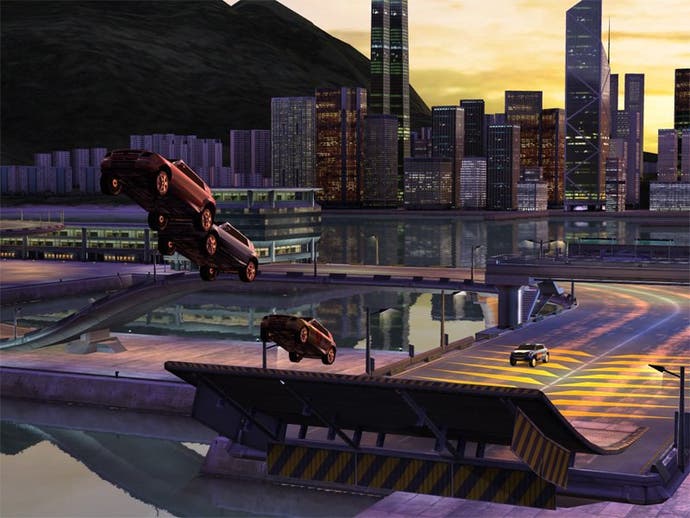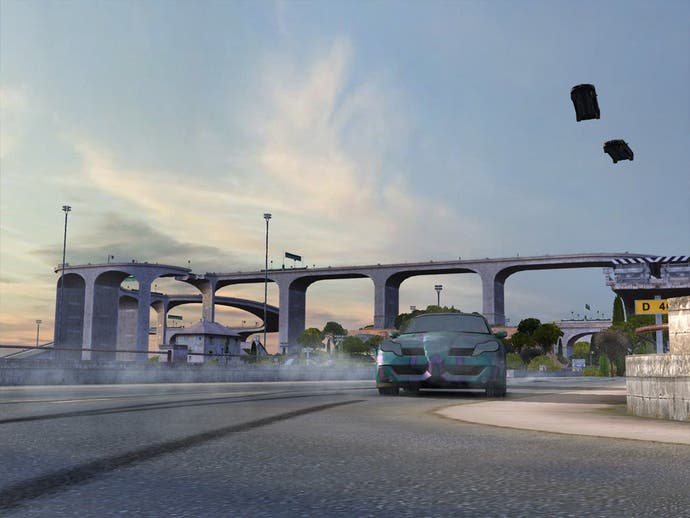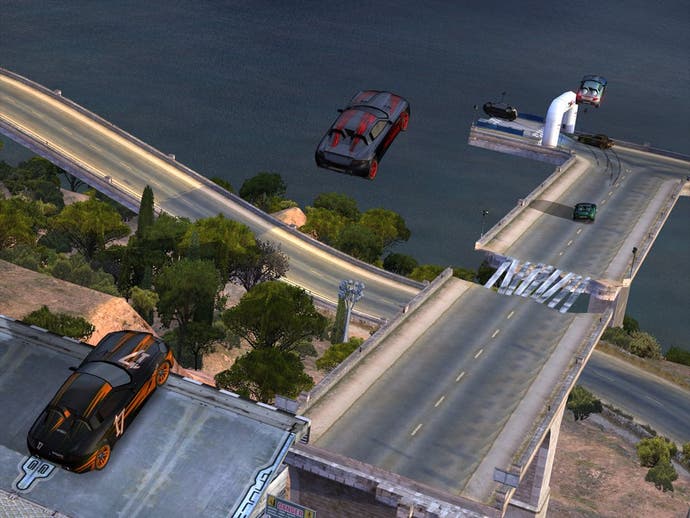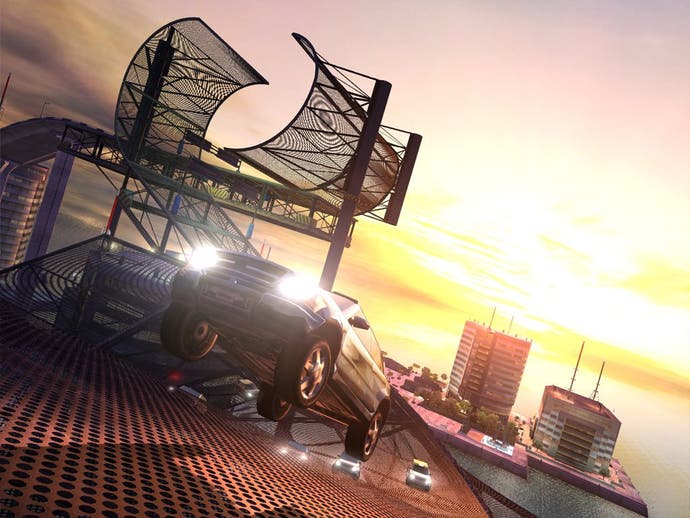TrackMania Sunrise review
I feel like marking it down for ruining my sleep patterns.

A wise friend once told me that you can try to be all things to all people, but in the end your heart shines through. He probably wasn't expecting me to recycle it in print, but it seems like the best way to summarise TrackMania Sunrise - a game whose lifeblood of racing is pumped by the heart of a puzzler.
Consider some of the puzzle games I've been playing lately. Meteos, Zoo Keeper, Lumines. All are united by a simplicity and elegance of concept and finesse in execution, with only the slightest of cracks emerging at the seams. Sunrise, like its predecessor, shares these characteristics - most obviously in the way it says bollocks to things like boosting, handbrakes and other arcade tendencies and uses only the cursor keys for control - and after a while it wears that puzzle heart on its sleeve.
The primary play modes may encourage fast and precise driving, but they encourage it like no other racing game on the planet. Your speed increases more or less exponentially the longer you go without taking your finger away from the accelerator or brushing a wall, the exaggerated physics let you hang in the air for ridiculous amounts of time and even apply the brakes slightly to slow your aerial momentum, and questions of collisions with other drivers and damage modelling never even arise. None of the main game modes even treat the other cars as physical objects. You can drive right through them. But I wouldn't have it any other way.
In Platform, a gameplay mode new to the sequel and now arguably my favourite, the goal is simply to reach the finish line whilst resetting to a previous checkpoint as few times as possible; the eventual goal being to complete the track without resetting at all. Why would you reset? Because the tracks are elaborate, rollercoastery affairs with enormous jumps, blind turns, Tony Hawk-style half-pipe transfers over water, and fiendishly designed hops, braking zones and other tricky sections that often demand thorough investigation not to mention enormous persistence to overcome. Of all the modes, Platform best illustrates how Sunrise becomes a game of instinctive high-speed reactions, and how players quickly become acclimatised to things like the weight distribution and mannerisms of the vehicles and the world, and quickly come to love them. It's already stolen the heart off my own sleeve.

Puzzle mode, meanwhile, was most emblematic of the original game and remains the element most cherished by the game's fanatical community. The idea, for those who missed the first game, is that you're given a track setting with start and finish points and checkpoints and then have to use various prescribed track pieces to engineer the most efficient route possible, before entering the world and trying to achieve a particular lap time. Normally there's an obvious strategy that yields bronze and perhaps silver medals, but there's usually a more devilish approach that has to be puzzled out to achieve a gold, and for this you'll have to use the editor to exploit the game's fondness for aerial activity amongst other things. The interface has been partially overhauled for Sunrise, making proper use of the mouse, and although it remains quirky it's quicker to use once you're used to it, and beyond that the developer, Nadeo, has expanded the world to include a broad variety of new track pieces that draw on the game's various environmental styles, with far more scenery pieces that, as demonstrated in Nadeo's own tracks, can also be woven into the fabric of a successful route to achieve top times.
Another new addition is Crazy mode. It'll take you a while to unlock, but when you do it quickly establishes its credentials. The idea here is that you're given a certain amount of time - say five minutes - in which to complete as many laps of the track as possible. Complete four for bronze, ten for silver, etcetera. But completed laps are only recorded toward your total if you finish them within the prescribed time limit, which decreases each time you complete a successful lap. It soon becomes frantic, as errors creep into your repeated sorties through the same obstacles and margin for error narrows, and in a nice touch there are also 15 ghost cars zooming along the same path to throw you off. If they do though, you only have yourself to blame; after a while each track's ghost selection is largely populated by replays of your own previous laps, including those you recorded as part of the same attempt.
The time trial-styled Race mode, finally, may seem the most familiar, with the goal simply being to reach the finish line in a certain time to win a medal - the route for each of which is played out alongside you by ghost cars, occasionally cluing you in to shortcuts. But in practice it's similarly unique to the others, with enormous, spiralling, loop-the-looping, twisty-turny tracks where blind turns and deceptive jumps are rarely as prevalent as they are in Platform mode, but the sense of speed and urgency combined with the frantic, last-minute adjustments often necessary before huge jumps offer a compensatory boost of adrenaline.

All four game modes are the sorts of things you pick away at again and again and again, striking the perfect balance between giving you glorious spectacles and compelling you to repeat them over and over to fine-tune. So much so that unlocking some of the levels becomes a question of completing things called Serie Cups, which task you with stitching your performances together in one uninterrupted flow. You choose whether to go for Bronze, Silver or Gold and then that medal's ghost car becomes your target to beat one each of the tracks in succession. Even the easiest Serie Cup is a massive undertaking on Gold, because you're effectively asked to string your finest moments up to that point together sequentially. Slip up enough to finish behind the ghost car even once and it's back to the first track.
Keeping things fresh as you progress through the cups are a number of different car types. Some are sleeker and faster than others (with a sense of speed and immediacy that occasionally puts the likes of F-Zero and even Ballistics, for those who remember that, to shame), while others have bouncier suspension and better traction, or prove themselves to be lumbering and slow to accelerate. Some can frustrate. The first car, for example, generally lands irretrievably on its back when it flips, which is a punishing design decision for a game where you spend so much time jumping through hoops - often literally - whereas the next, a 4x4, can often be coaxed into righting itself when all appears lost. But instead of some being worse than others, they all eventually come to represent a difference of approach and reinvention - in the same way that Meteos unlocks new levels where the playing conditions are so dramatically different that it can feel like a different game each time.
Visually it's incredibly clean and well defined, and manages to uphold a ridiculously high level of detail - watch out for the moisture on the road surface as the camera pans to catch the sun's reflection in it, and the use of mesh-like road surfaces to increase the amount of things being thrust into your brain at any given moment exponentially - and yet it doesn't sacrifice the immediacy of restarts. One of the key components of Sunrise's compelling nature is that hitting Enter brings you back to the last checkpoint like a snap of the fingers, and the same is true of hitting Delete to take you back to the starting point. In other words, the game must somehow cache all of this detail for instant access. When you've seen it in motion - and particularly if you get the chance to play it on a huge screen, as I did - you'll wonder how on earth it's done.

Nadeo's is the story of a developer that knows its product inside and out, understands how to make it most spectacular and engaging - right down to knowing exactly where to position certain environmental objects to spin you round in midair so you'll squeeze through a snug gap and land the right way up - and follows every element through beyond what other companies would consider the logical, not to mention financially viable, conclusion. If anything's symbolic of that last comment it's the game's online functionality. You can quickly and easily check for and download new community-built campaigns entirely in-game. Nadeo's even released a car editor - pre-release. And as well as offline hot seat and LAN multiplayer options there are various competitive online modes. My personal favourite being the repeated time trial bit, where you continuously try and better you own lap on a track whilst other players represented on-screen by ghost cars zoom around you doing likewise; the winner being the person with the best lap time after a certain overall time limit for the level is hit. As well as being ludicrous entertainment it's also a hugely social experience, with players often taking a breather to swap banter via on-screen messaging while others try in vain to beat their times.
Granted, the game is undeniably frustrating, but it's also utterly compelling. Whether the difficulty curve suits you is something perhaps best left for the demo to help you decide, but if that does grab you then you'll be pleased to learn that it raises the bar progressively throughout - and the compulsion associated with even the most fiendish tasks (the Platform level that involves a jump from one down-angled slope to another narrow version in a car that has virtually no traction springs to mind) all comes back to that puzzle game allure at its heart. The concept is so simple and elegant, the design of the tracks so intelligent, the restarts so immediate, that even when you're plugging away at the same section repeatedly it feels like one continuous challenge.

What's more, it's full of joyous moments - and so much more grandstanding than its predecessor. Particularly because through revisiting stages so much you eventually stumble upon a deliberate quirk of Nadeo's design, like catching the last jump in a fitful sequence, fearing you're about to come up short and land in the water only to skip like a stone from the surface and through the finish line. It's like they're winking at you. You're left just wanting to hug them back.
You can argue that the relentless "try, try and try again" repetition won't appeal to everyone, but it's a different kind of repetition to the soul-destroying grind of so many modern games - most obviously comparable to something like SSX, where you wind up continually restarting until you can complete the first section to your utmost satisfaction, and the only barrier to enjoyment is the pain of having to wait for the game to restart when you foul up. Sunrise doesn't even erect that barrier.
Compared to its predecessor, it looks better, moves faster, throws you further and loves you more. The track design is more extraordinary than ever and full of flourishes that I can barely begin to emulate with my own creations, the new gameplay modes fit right in, and indeed Platform is arguably more addictive than anything in the first game all by itself. There is more of the same in here, but it's more of the same with 900mph flying bells on, and the result is a must-buy game. An exquisite synthesis of the racing and puzzle genres.


